 Ever since they’d announced that they were going to blow up the Didcot Power Station Southern Cooling Towers I got it into my head that they deserved a flypast. Didcot Power Station is that rather large feature east of the A34 near Abingdon. The South Towers are those closest to the A34 alongside the Great Western Railway. Building started in 1964 and it went online (that’s supplying the National Grid for you computer types) in 1970. Strangely for such a large feature it creeps up on you, bit like Tintern Abbey. This is in no small part thanks to its architect Sir Frederick Gibbert who was responsible for, amongst other things, chunks of Heathrow Airport, most of Harlow New Town and the Liverpool Cathedral. He actually won a Civic Award back in 1968 in recognition of how well it ‘blended into the landscape’.
Ever since they’d announced that they were going to blow up the Didcot Power Station Southern Cooling Towers I got it into my head that they deserved a flypast. Didcot Power Station is that rather large feature east of the A34 near Abingdon. The South Towers are those closest to the A34 alongside the Great Western Railway. Building started in 1964 and it went online (that’s supplying the National Grid for you computer types) in 1970. Strangely for such a large feature it creeps up on you, bit like Tintern Abbey. This is in no small part thanks to its architect Sir Frederick Gibbert who was responsible for, amongst other things, chunks of Heathrow Airport, most of Harlow New Town and the Liverpool Cathedral. He actually won a Civic Award back in 1968 in recognition of how well it ‘blended into the landscape’.  Well I suppose it does from some angles but by 2003 it managed to come third in a ‘worst eyesore survey’ and English Heritage declined to give it a Listed Building status of any sort. Clearly there are others in much more tranquil settings that are more deserving like the one at the end of the Ironbridge Gorge with pink cooling towers which I once took off next to which was quite hairy. I actually thought Didcot ‘A’, as it is affectionally known, was quite handy as you could see it for miles from the air so made a smashing landmark and when it closed in early 2013 we all lost a very fine wind indicator and the locals a fine outstanding source of pollution, the second most polluting power station in Britain apparently. On days of strong inversions you could clearly see the sulphur layer which spread out from it so they may have had a point. It probably won’t be missed by many but in its day it was a huge employer and a very
Well I suppose it does from some angles but by 2003 it managed to come third in a ‘worst eyesore survey’ and English Heritage declined to give it a Listed Building status of any sort. Clearly there are others in much more tranquil settings that are more deserving like the one at the end of the Ironbridge Gorge with pink cooling towers which I once took off next to which was quite hairy. I actually thought Didcot ‘A’, as it is affectionally known, was quite handy as you could see it for miles from the air so made a smashing landmark and when it closed in early 2013 we all lost a very fine wind indicator and the locals a fine outstanding source of pollution, the second most polluting power station in Britain apparently. On days of strong inversions you could clearly see the sulphur layer which spread out from it so they may have had a point. It probably won’t be missed by many but in its day it was a huge employer and a very  advanced coal burning power station which later went on to be able to use a coal and natural gas mix along with biomass like what the Savernake Forest is. As for the Towers themselves they are a type known as hyperboloid and are the smoothest ever built. They are a very complicated and difficult shape to construct and I think they are fantastic in an engineering sort of way. Robin explained that they were not prefabricated in the traditional way of building cooling towers at the time but the concrete was poured stage by stage, section by section, barrow load by barrow load.
advanced coal burning power station which later went on to be able to use a coal and natural gas mix along with biomass like what the Savernake Forest is. As for the Towers themselves they are a type known as hyperboloid and are the smoothest ever built. They are a very complicated and difficult shape to construct and I think they are fantastic in an engineering sort of way. Robin explained that they were not prefabricated in the traditional way of building cooling towers at the time but the concrete was poured stage by stage, section by section, barrow load by barrow load.
 Now Robin Double-Barrelled not only lives nearby and has a pretty respectable circle of farmer friends but he also used to work there, as it goes, so a mail went off asking if he could help with a launchsite. Back came the response that he would be more than happy but it appeared that Jonathan Harris and he were already on the case for a 3.4.40. Region bash. On the mailing list we went and Sunday 20th looked hopeful but then the wind was a tad strong to mess about so even if it was called we’d have chosen to dip out. Monday however was looking a lot better but then Simon Calvert called from Ireland to ask for a check flight. This didn’t bode well as a visit to Thruxton to watch the test flying of Phil Lawton’s Hurricane was also planned for Monday but as a weather slot in Ireland is one not to be missed, so fickle is their weather, I felt I was honour bound to oblige, after all the Hurricane wasn’t due to depart for at least a week so there would be another opportunity to see that but the Towers would be gone by the 26th July. It was cutting it close. Then it turned out that rascal John Rose had actually cracked it on the Monday with a basket load of passengers although he did report that it was a tad breezy! Apart from the weather not being quite right we were tied up Wednesday and Thursday so they were out, then Friday looked unlikely on account that it was probably going to be foggy in the morning and be about a 110º in the shade so most likely not that stable in the evening. There looked like a chance on Saturday 26th July but that would be it as they would be no more by dawn Sunday. I called DB. “Saturday evening is looking promising but the morning is better but I may have a check flight to do from Silverstone so let’s look at the evening slot. I’ll call you Friday.” “Right Ho, I’ll see what we can do and do you want to use the MG balloon?” the ever helpful DB offered. Brilliant, this was looking like a serious chance. The MG balloon, G-BWSB, is a Lindstrand 105A so would be perfect. Built for MG, who originally manufactured their sports cars at nearby Abingdon, it nearly has Morlands Brewery’s logo on it. Best known for Speckled Hen in honour of the paint finish on early MGs the emblem on the Morlands bottles is a crib of the MG badge. Thankfully they now produce Old Crafty Hen at six point something silly, which was a bit more appropriate and mysteriously very drinkable. I am wandering off the plot here but all in all everything was looking just right and now we had a nice local theme. Come Friday, and by mutual consent following a long conversation, the check flight was pencilled in for the Saturday evening. Saturday morning it would be after all. Quick call to Rob who confirmed the local met were giving a northerly and that launching from near Culham would be the best option. I suggested we meet at 5.15. There was a sharp intake of breath and the line went dead. I called Barry the Camera late, freshly home from the Swan, and got a similar reaction. We were on.
Now Robin Double-Barrelled not only lives nearby and has a pretty respectable circle of farmer friends but he also used to work there, as it goes, so a mail went off asking if he could help with a launchsite. Back came the response that he would be more than happy but it appeared that Jonathan Harris and he were already on the case for a 3.4.40. Region bash. On the mailing list we went and Sunday 20th looked hopeful but then the wind was a tad strong to mess about so even if it was called we’d have chosen to dip out. Monday however was looking a lot better but then Simon Calvert called from Ireland to ask for a check flight. This didn’t bode well as a visit to Thruxton to watch the test flying of Phil Lawton’s Hurricane was also planned for Monday but as a weather slot in Ireland is one not to be missed, so fickle is their weather, I felt I was honour bound to oblige, after all the Hurricane wasn’t due to depart for at least a week so there would be another opportunity to see that but the Towers would be gone by the 26th July. It was cutting it close. Then it turned out that rascal John Rose had actually cracked it on the Monday with a basket load of passengers although he did report that it was a tad breezy! Apart from the weather not being quite right we were tied up Wednesday and Thursday so they were out, then Friday looked unlikely on account that it was probably going to be foggy in the morning and be about a 110º in the shade so most likely not that stable in the evening. There looked like a chance on Saturday 26th July but that would be it as they would be no more by dawn Sunday. I called DB. “Saturday evening is looking promising but the morning is better but I may have a check flight to do from Silverstone so let’s look at the evening slot. I’ll call you Friday.” “Right Ho, I’ll see what we can do and do you want to use the MG balloon?” the ever helpful DB offered. Brilliant, this was looking like a serious chance. The MG balloon, G-BWSB, is a Lindstrand 105A so would be perfect. Built for MG, who originally manufactured their sports cars at nearby Abingdon, it nearly has Morlands Brewery’s logo on it. Best known for Speckled Hen in honour of the paint finish on early MGs the emblem on the Morlands bottles is a crib of the MG badge. Thankfully they now produce Old Crafty Hen at six point something silly, which was a bit more appropriate and mysteriously very drinkable. I am wandering off the plot here but all in all everything was looking just right and now we had a nice local theme. Come Friday, and by mutual consent following a long conversation, the check flight was pencilled in for the Saturday evening. Saturday morning it would be after all. Quick call to Rob who confirmed the local met were giving a northerly and that launching from near Culham would be the best option. I suggested we meet at 5.15. There was a sharp intake of breath and the line went dead. I called Barry the Camera late, freshly home from the Swan, and got a similar reaction. We were on.
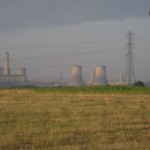 As arranged and probably on auto-pilot we met up at 5.15. Sadly Barry had phoned at four to say he couldn’t make it however very late Friday DB had texted Team Harris who were at Silverstone and invited them down to crew if they would be so kind. So it was that standing in a field overlooking the Power Station with a met that definitely gave a northerly we had a surface wind that was about 45º out but high, very high up, the clouds were moving the right way but for now it looked like we’d end up over Didcot Railway Centre, not too terrible in itself but not the purpose of the flight. Without a launch site further west being possible and without met balloons to let off, in proper seat of the pants traditional ballooning way, we decided to shift as far across the field as we could and give it our best shot. Robin and Jane elected to retrieve and Jonathan and his dad Stephen clambered aboard. We lifted off and went due east then nipped smartly up to around 1500 foot and found ourselves going right of the Towers. “Yes”, we cried. Suddenly this was perfectly possible and to say we were elated would be a very serious understatement.
As arranged and probably on auto-pilot we met up at 5.15. Sadly Barry had phoned at four to say he couldn’t make it however very late Friday DB had texted Team Harris who were at Silverstone and invited them down to crew if they would be so kind. So it was that standing in a field overlooking the Power Station with a met that definitely gave a northerly we had a surface wind that was about 45º out but high, very high up, the clouds were moving the right way but for now it looked like we’d end up over Didcot Railway Centre, not too terrible in itself but not the purpose of the flight. Without a launch site further west being possible and without met balloons to let off, in proper seat of the pants traditional ballooning way, we decided to shift as far across the field as we could and give it our best shot. Robin and Jane elected to retrieve and Jonathan and his dad Stephen clambered aboard. We lifted off and went due east then nipped smartly up to around 1500 foot and found ourselves going right of the Towers. “Yes”, we cried. Suddenly this was perfectly possible and to say we were elated would be a very serious understatement.  Down we came again and around 500 foot we started swinging back left. Loads of steerage, a nice stable speed such that even I shouldn’t be able to miss this! Back up and hold our breath, then gently down, and down and then down a little bit more. Now we were heading straight for the middle of the first three North Towers. We laughed out loud, this was just brilliant. Without the steam billowing out and the heaps of coal all gone the place looked small and strangely strange. There wasn’t a soul in sight. The air was as stable as you could have wished. A long time ago, coming from the south in the Guinness Can, I once tried to land on the playing fields in front of them whilst they were in full chuff mode. As I got low I suddenly found myself hurtling across Didcot as a result of the air being dragged in around the bottom of the Towers. Muppet me, suddenly recalling that was how they worked, I turned everything on, shut my eyes and ended up at 3,500 foot amongst the smuts, steam and sulphur. Ever since then I’ve always had a healthy regard for them. I’d spotted the playing fields I’d tried to land on all those years before so an approach over the Power Station and landing there would seem most appropriate.
Down we came again and around 500 foot we started swinging back left. Loads of steerage, a nice stable speed such that even I shouldn’t be able to miss this! Back up and hold our breath, then gently down, and down and then down a little bit more. Now we were heading straight for the middle of the first three North Towers. We laughed out loud, this was just brilliant. Without the steam billowing out and the heaps of coal all gone the place looked small and strangely strange. There wasn’t a soul in sight. The air was as stable as you could have wished. A long time ago, coming from the south in the Guinness Can, I once tried to land on the playing fields in front of them whilst they were in full chuff mode. As I got low I suddenly found myself hurtling across Didcot as a result of the air being dragged in around the bottom of the Towers. Muppet me, suddenly recalling that was how they worked, I turned everything on, shut my eyes and ended up at 3,500 foot amongst the smuts, steam and sulphur. Ever since then I’ve always had a healthy regard for them. I’d spotted the playing fields I’d tried to land on all those years before so an approach over the Power Station and landing there would seem most appropriate.
 The cooling towers, the ‘North Towers’ and the ‘South Towers’, occupy each end of the 300 acre site in two triangles of three. With all the steerage it looked very much like we could get both sets but we’d have to perform a bit of a jig-a-jig between them. For their part the cooling towers were playing well-dormant and somehow they just didn’t look that big or threatening despite standing well over 350 foot high. They just looked lonely. A bit more left was selected and then, electing to climb rather than give them a resounding clonk, we sailed up and over the Northern Towers which were to be spared for a while yet. As we crossed the lip of the first we just gawped into the chasm below us and let out a bit of a ‘Wow!’ They looked surprisingly and oddly delicate. Close up they looked even smoother and splendid, a tribute to concrete engineering in the best possible way. You felt that a tap with a stick or the basket would have resulted in a chip. It was tempting to drop in but the wind was just that bit too fast. In hindsight, probably a good thing! Looking straight down them was, I must admit, rather unnerving. In the bottom all the condensing gear was still in place. Wicked, these were still in working condition and believe me they were enormous. We saluted their magnificence and floated on.
The cooling towers, the ‘North Towers’ and the ‘South Towers’, occupy each end of the 300 acre site in two triangles of three. With all the steerage it looked very much like we could get both sets but we’d have to perform a bit of a jig-a-jig between them. For their part the cooling towers were playing well-dormant and somehow they just didn’t look that big or threatening despite standing well over 350 foot high. They just looked lonely. A bit more left was selected and then, electing to climb rather than give them a resounding clonk, we sailed up and over the Northern Towers which were to be spared for a while yet. As we crossed the lip of the first we just gawped into the chasm below us and let out a bit of a ‘Wow!’ They looked surprisingly and oddly delicate. Close up they looked even smoother and splendid, a tribute to concrete engineering in the best possible way. You felt that a tap with a stick or the basket would have resulted in a chip. It was tempting to drop in but the wind was just that bit too fast. In hindsight, probably a good thing! Looking straight down them was, I must admit, rather unnerving. In the bottom all the condensing gear was still in place. Wicked, these were still in working condition and believe me they were enormous. We saluted their magnificence and floated on. 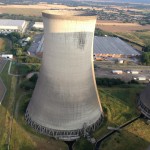 Now we needed left followed by a tablespoon of right if we were going to square up the next set. Didcot ‘B’, the gas plant off to our right is still running and luckily for us there was a tell-tale whisp of steam showing us that low down there was still plenty of the necessary. So by dropping a bit we should hook a left and get neatly over the doomed Southern Towers missing the old Boiler House and Main Chimney and be all lined up for the playing fields beyond.
Now we needed left followed by a tablespoon of right if we were going to square up the next set. Didcot ‘B’, the gas plant off to our right is still running and luckily for us there was a tell-tale whisp of steam showing us that low down there was still plenty of the necessary. So by dropping a bit we should hook a left and get neatly over the doomed Southern Towers missing the old Boiler House and Main Chimney and be all lined up for the playing fields beyond.  Its quite a distance between the two clusters of towers so down we went the 600 foot chimney off to our left, turned left as predicted, hit the burners and then up we came, picked up a nifty bit of right hand down number one and got another perfect track. Talk about a great big bit of luck. With the first two off to our left and right we went dead centre across the last fellow. Magic. Looking down we could clearly see their triangular supports clearly toshed up with explosive and probably all wired and ready to be blasted to smithereens. We took the box of matches off of Jonathan. Now this is where I had one of those moments. The very last Tower, the top one of the triangle, appeared to have part of the walkway left in place at the very bottom and the scene out of Brazil sprung to mind but hard as I looked I was relieved not to spot a Messerschmitt bubble car lurking in the shadows.
Its quite a distance between the two clusters of towers so down we went the 600 foot chimney off to our left, turned left as predicted, hit the burners and then up we came, picked up a nifty bit of right hand down number one and got another perfect track. Talk about a great big bit of luck. With the first two off to our left and right we went dead centre across the last fellow. Magic. Looking down we could clearly see their triangular supports clearly toshed up with explosive and probably all wired and ready to be blasted to smithereens. We took the box of matches off of Jonathan. Now this is where I had one of those moments. The very last Tower, the top one of the triangle, appeared to have part of the walkway left in place at the very bottom and the scene out of Brazil sprung to mind but hard as I looked I was relieved not to spot a Messerschmitt bubble car lurking in the shadows. 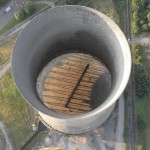
As we climbed away and looked back the sight was quite dramatic and it was clear to see how much had already been cleaned up and carted away. The site was tidy and somehow looked like it was awaiting a delivery of coal and commissioning rather than about to cease to exist. Sadly all the grassy areas that once filled the spaces between the structures were mostly gone or unkempt and the place did have really sad look of impending doom about it. Twenty four hours on and the Southern Towers would all be gone and in eighteen months time Didcot ‘A’ would be history. We‘d managed the crossing just in time and what a crossing, bang on across the middle of the North and South Towers. Maybe I’d picked up a bit of the luck of the Irish or more likely it was DB’s choice of launchfield. Mind you, as always in ballooning, it is mainly 99% luck.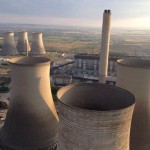
We looked back once more and bade a fond farewell to the South Towers and left them to their fate. Now we concentrated on getting to the landing site safe in the knowledge there would be no cooling towers exerting their influence on us this time! With the winds still lovely, as planned, we dropped into the sports field, touched down then after a good look round decided that the six foot high fence and gates  that had appeared in the intervening years looked pretty impenetrable. No worries, ahead lay what appeared to be a grass field followed by a couple of cut rape fields with a road snaking between. Our name was on them all so off we went again and dropped down over the outskirts of Didcot but the grass field became rye grass as we closed on it so it was the cut rape a swathe of which had been topped. Through some nettles to scuff off some speed, pilots off and ‘bonk’ we were down. The envelope settled onto the taller stems so it was easy enough to gently pull it off. It was only quarter to seven but the leaves were rustling, any later and it would have been a tad squirly to have courted the Towers so intimately.
that had appeared in the intervening years looked pretty impenetrable. No worries, ahead lay what appeared to be a grass field followed by a couple of cut rape fields with a road snaking between. Our name was on them all so off we went again and dropped down over the outskirts of Didcot but the grass field became rye grass as we closed on it so it was the cut rape a swathe of which had been topped. Through some nettles to scuff off some speed, pilots off and ‘bonk’ we were down. The envelope settled onto the taller stems so it was easy enough to gently pull it off. It was only quarter to seven but the leaves were rustling, any later and it would have been a tad squirly to have courted the Towers so intimately.  We looked back at them standing quietly over Didcot. We’d been there. It would be strange without them. Then to mark the occasion, with a large smiles on our faces, we all shook hands. In a very unprofessional way Robin and Jane rocked up before the envelope was in the bag. Local knowledge on Robin’s part soon had the owner located and so it was off for tea and bacon sandwiches at Steve Froud’s courtesy of his missus Debbie. Now Steve is a fine fellow and not at all shy and retiring. His front porch looks directly at the Southern Towers. As a purveyor of fine (and mostly very experimental beer and ale) he had every intention of setting up the Barbie about three o’clock in the morning and await the explosion. Well sated and armed with a case or two of equally explosive looking Brew Number 9 we proffered our thanks and left him taping up his front windows. Next stop was afters at the home-made ice-cream shop and then back to the launchsite where our host Neil Irwin turned up to see how it had all gone and also admitted that he was going to drag a
We looked back at them standing quietly over Didcot. We’d been there. It would be strange without them. Then to mark the occasion, with a large smiles on our faces, we all shook hands. In a very unprofessional way Robin and Jane rocked up before the envelope was in the bag. Local knowledge on Robin’s part soon had the owner located and so it was off for tea and bacon sandwiches at Steve Froud’s courtesy of his missus Debbie. Now Steve is a fine fellow and not at all shy and retiring. His front porch looks directly at the Southern Towers. As a purveyor of fine (and mostly very experimental beer and ale) he had every intention of setting up the Barbie about three o’clock in the morning and await the explosion. Well sated and armed with a case or two of equally explosive looking Brew Number 9 we proffered our thanks and left him taping up his front windows. Next stop was afters at the home-made ice-cream shop and then back to the launchsite where our host Neil Irwin turned up to see how it had all gone and also admitted that he was going to drag a  barbeque out to the middle of the field and watch the Towers’ demise. Sadly his view would be a bit impeded by the Turbine Hall but the bonus would be that it would protect his farm from flying rubble! We all agreed that another flight as soon as possible would be needed to inspect the remains but it wouldn’t be a touch on this mornings flight. For me it ranks as ‘flights to remember’ alongside landing next to Stonehenge and floating amongst the dinosaurs at the Crystal Palace.
barbeque out to the middle of the field and watch the Towers’ demise. Sadly his view would be a bit impeded by the Turbine Hall but the bonus would be that it would protect his farm from flying rubble! We all agreed that another flight as soon as possible would be needed to inspect the remains but it wouldn’t be a touch on this mornings flight. For me it ranks as ‘flights to remember’ alongside landing next to Stonehenge and floating amongst the dinosaurs at the Crystal Palace.
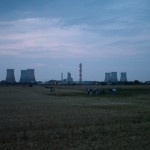 So what happened next? Well they only went and blew them up at 05.01 Sunday morning the rascals. Despite many protests nPower or whatever they are now called and the demolition contractors, Coleman and Company, refused to move the timing to after sunrise, according to them it was on the advice of the police and Health & Safety however it was widely published as happening at about 03.00 but as with all these things a NOTAM had been issued active between 04.45 to 05.30 and upto 700 foot above sea level. So there was a clue. In the event it was first light when the man pressed the button and the Towers were down in ten seconds. According to the DBs the surrounding area was absolutely full of spectators some of whom camped out all night. The blast of the 180kg of explosives required to topple the three towers (which it is claimed amounted to 36,000 tonnes of concrete) was heard several miles away but Steve Froud’s windows were unharmed.
So what happened next? Well they only went and blew them up at 05.01 Sunday morning the rascals. Despite many protests nPower or whatever they are now called and the demolition contractors, Coleman and Company, refused to move the timing to after sunrise, according to them it was on the advice of the police and Health & Safety however it was widely published as happening at about 03.00 but as with all these things a NOTAM had been issued active between 04.45 to 05.30 and upto 700 foot above sea level. So there was a clue. In the event it was first light when the man pressed the button and the Towers were down in ten seconds. According to the DBs the surrounding area was absolutely full of spectators some of whom camped out all night. The blast of the 180kg of explosives required to topple the three towers (which it is claimed amounted to 36,000 tonnes of concrete) was heard several miles away but Steve Froud’s windows were unharmed. 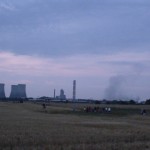 The contractors followed up the demolition with a thorough clean up operation which is set to be ongoing for a few days yet but the closed roads and railways were pronounced clear by 07.00. Thinking about it we could have flown over the event after all. We called into the old Didcot ‘A’ Induction Car Park, as it was somewhat carelessly called, on our way back from Thruxton on Sunday afternoon to show Barry what he’d missed. The place was full of curious spectators. I wish I’d had an ice-cream van! There was a pretty impressive pile of rubble but the most southerly of towers, the last one we flew over, was still standing to about 30 foot on its legs. So we have great pictures before and after of the base of that tower. You know what? I reckon it was just making a point and when they’ve cleared it all up we’ll have a nice launchsite. Huge thanks then to Jane, DB, Neil, the Frouds and Lady Luck. Pictures courtesy of Team Harris, Mrs DB, Barry and Jane.
The contractors followed up the demolition with a thorough clean up operation which is set to be ongoing for a few days yet but the closed roads and railways were pronounced clear by 07.00. Thinking about it we could have flown over the event after all. We called into the old Didcot ‘A’ Induction Car Park, as it was somewhat carelessly called, on our way back from Thruxton on Sunday afternoon to show Barry what he’d missed. The place was full of curious spectators. I wish I’d had an ice-cream van! There was a pretty impressive pile of rubble but the most southerly of towers, the last one we flew over, was still standing to about 30 foot on its legs. So we have great pictures before and after of the base of that tower. You know what? I reckon it was just making a point and when they’ve cleared it all up we’ll have a nice launchsite. Huge thanks then to Jane, DB, Neil, the Frouds and Lady Luck. Pictures courtesy of Team Harris, Mrs DB, Barry and Jane.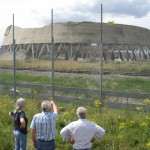
http://www.rwe.com/web/cms/en/2373710/rwe-npower/about-us/our-businesses/power-generation/didcot/deconstruction-of-didcot-a/ RWE’s (npower) description of the demolition process.
http://wherecloudsaremade.blogspot.co.uk/2013/02/tracing-origins-of-didcot-power-station.html nice bit with pictures of the early building work
http://www.youtube.com/watch?v=j70kiQy277A Demolition of the South Towers
 And here’s a link to a movie of the flight itself, which your browser should (might) open for you, if you’re patient (Grandma! Cover your ears! Ed.)
And here’s a link to a movie of the flight itself, which your browser should (might) open for you, if you’re patient (Grandma! Cover your ears! Ed.)
